Morocco’s first-ever Women’s World Cup didn’t get off to the best start, as they suffered a 6-0 thumping against Germany, quickly slapping them with a harsh reality check amid talk of the Women’s National Team emulating the Men’s National Team from the 2022 Men’s World Cup and progressing beyond what was expected of them.
However, we now sit here after game three with Germany knocked out and Morocco progressing to the knockout stages of this tournament, with the Atlas Lionesses earning back-to-back 1-0 wins, firstly over Korea Republic and secondly over Colombia.
The underdogs got the last laugh and now hold the honour of calling themselves the lowest-ranked team, per the FIFA World Rankings, to make it through to the knockout rounds from the groups — something they can be immensely proud of.
The scenes on the pitch after their game, once the Moroccan players discovered they would advance to the next phase of the competition, were very emotional and epitomised what sport, in general, is all about.
So, how did Morocco recover from a devastating opening game defeat in which they shipped six goals to Germany and end up keeping two clean sheets in a row to finish above Die Nationalelf?
This tactical analysis and team-focused scout report will highlight some of the significant defensive issues former Lyon coach Reynald Pedros’ team displayed in their opening game, and how they addressed those problems with their tactics in subsequent games to create a very solid unit off the ball.
Preventing passes into the opponent’s midfield
When setting up in a mid-block, the goal is to deny the opponent easy opportunities to progress the ball into dangerous areas in the middle of the park or the final third. Morocco did a terrible job of denying Germany those opportunities, as the beginning of this section will explore.
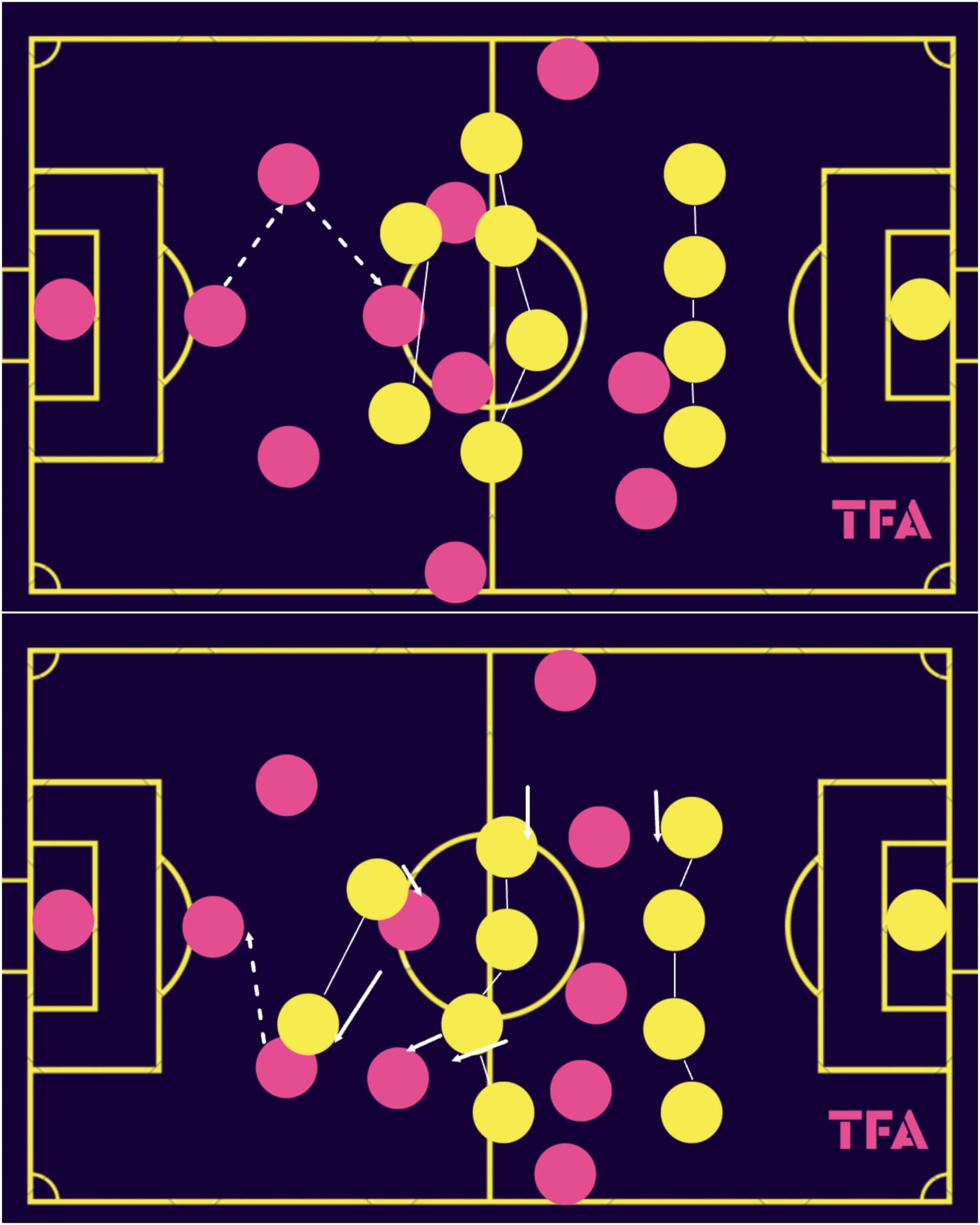
Figure 1 shows an example of Morocco’s 4-4-2 mid-block versus Germany’s in-possession shape, which ultimately became a 3-2-5, as the bottom image displays.
At the beginning of this sequence, in the top image, the ball was played from Germany’s central centre-back to the left centre-back, which dragged Morocco’s right centre-forward away from the centre and towards the left-sided German ‘8’, who had dropped to provide a decent short passing option on this side of the pitch.
The two Moroccan centre-forwards were split quite wide apart, allowing the left centre-back to play the short diagonal pass into midfield to a German midfielder with time and space to turn.
At times in the first game, there seemed to be no attempt at screening passes into midfield from the Moroccan centre-forwards, though they would still make a clear attempt at recovering the ball after it reached midfield — often too little, too late.
At times, there was some relatively poor pressing on an individual level, with players failing to check their shoulders to see what movement was happening behind them. For the centre-forwards, this often allowed Germany’s holding midfielder to move to the side and escape their cover shadow, freeing herself up to receive the ball.
In the bottom image, as the ball makes its way out to Germany’s right centre-back at about the 18-minute mark in this contest, we catch a glimpse of how Morocco’s position-oriented zonal marking structure typically worked.
The Moroccan players were concerned with occupying the space assigned to them, not the players. They took this to an extreme in this game, following German players out of their area very, very little before returning to their designated spot in the 4-4-2 structure.
For instance, as Germany’s right holding midfielder, Sara Däbritz, drops here, Morocco’s left central midfielder follows as far as we’ve indicated here before returning home — so not that far at all.
This had positives in that it allowed Morocco to maintain a clear, solid structure without players getting dragged all over the pitch, needlessly expending energy and allowing massive holes to open in their defensive shape for the opposition to exploit.
However, at the same time, it often allowed German players to escape markers easily and find space somewhere else on the pitch, as players weren’t switched between Moroccan players before they left them free, meaning at this point above, Däbritz was unmarked while still occupying a fairly dangerous playmaking position.
With Morocco’s failure to adequately screen passes into midfield in game one, it was not ideal that midfielders could find freedom in such valuable areas so easily.
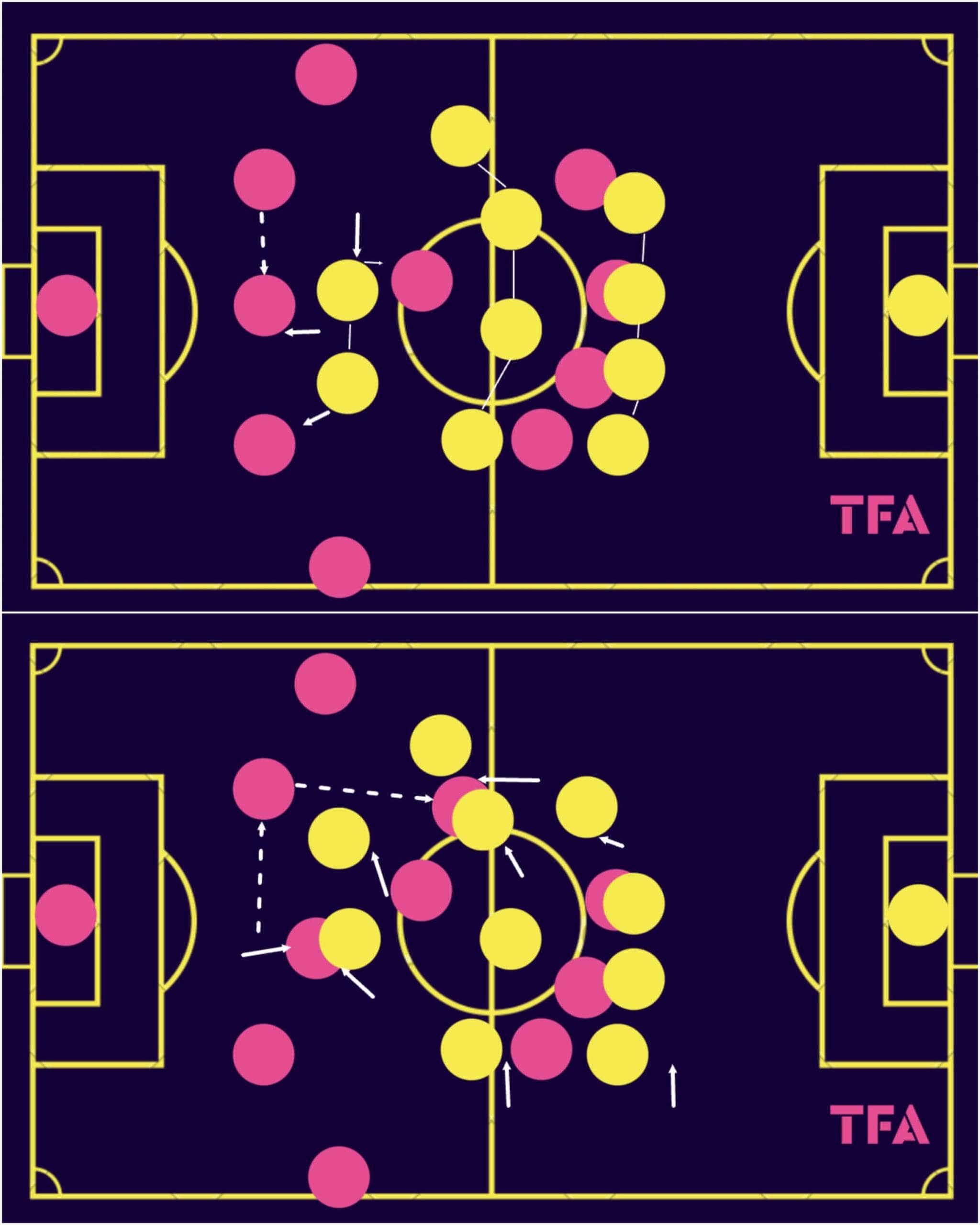
Our following example is taken from Morocco’s crucial third game versus Colombia, in about the 40th minute. Again, Morocco lined up in a position-oriented 4-4-2 defensive structure while the opponent again played with a 4-2-3-1 but used something of a 5-1 build-up structure, with both full-backs remaining quite deep at the same time as one holding midfielder dropped in between the centre-backs.
The big difference in this case versus Colombia and Korea Republic compared to Germany was the quality of the pressing from Morocco’s centre-forwards and the ability they demonstrated to screen passes into midfield correctly.
In the top image, the holding midfielder who’s dropped between the centre-backs has the ball. But his pathway into midfield is blocked by the Moroccan players’ positioning, especially the right centre-forward, who’s scanning frequently at appropriate times to ensure the midfielder behind her doesn’t find freedom.
As the play moves on into the bottom image, the midfielder has passed sideways to the left centre-back.
This pass triggers movement all around, including from Morocco’s right centre-forward who quickly darts to position herself between the new ball carrier and the midfielder in that valuable central position.
Seeing the pathway into midfield blocked, Colombia’s left winger, Atlético Madrid’s Leicy Santos, drops to provide the left centre-back with a forward passing option. As she drops, she’s followed briefly by the Moroccan right-back before she’s passed off to the right central midfielder, who picks her up at around the halfway line.
This doesn’t deter the Colombian centre-back from playing the forward pass, but after the winger receives, she’s quickly dispossessed by a tackle from the right central midfielder, which sets up a dangerous counterattacking opportunity for the Atlas Lionesses.
This highlights not just how Morocco’s screening was better after game one but also their marking and how the players passed off opposition players between one another, minimising the amount of free time they’d have to receive between the lines.
The wingers’ role in the press
Another big issue for Morocco in game one was the way in which their wingers often found themselves in ‘no person’s land’, so to speak, due to their role in the press and how it was exploited time and time again by Germany.
As we saw before, Germany attacked with three players in the backline and advanced wide options on either side — something Reynald Pedros’ side didn’t have to face in either of their other two games. This may provide a blueprint for France on how they must approach the build-up and ball progression phases versus the exciting underdogs.
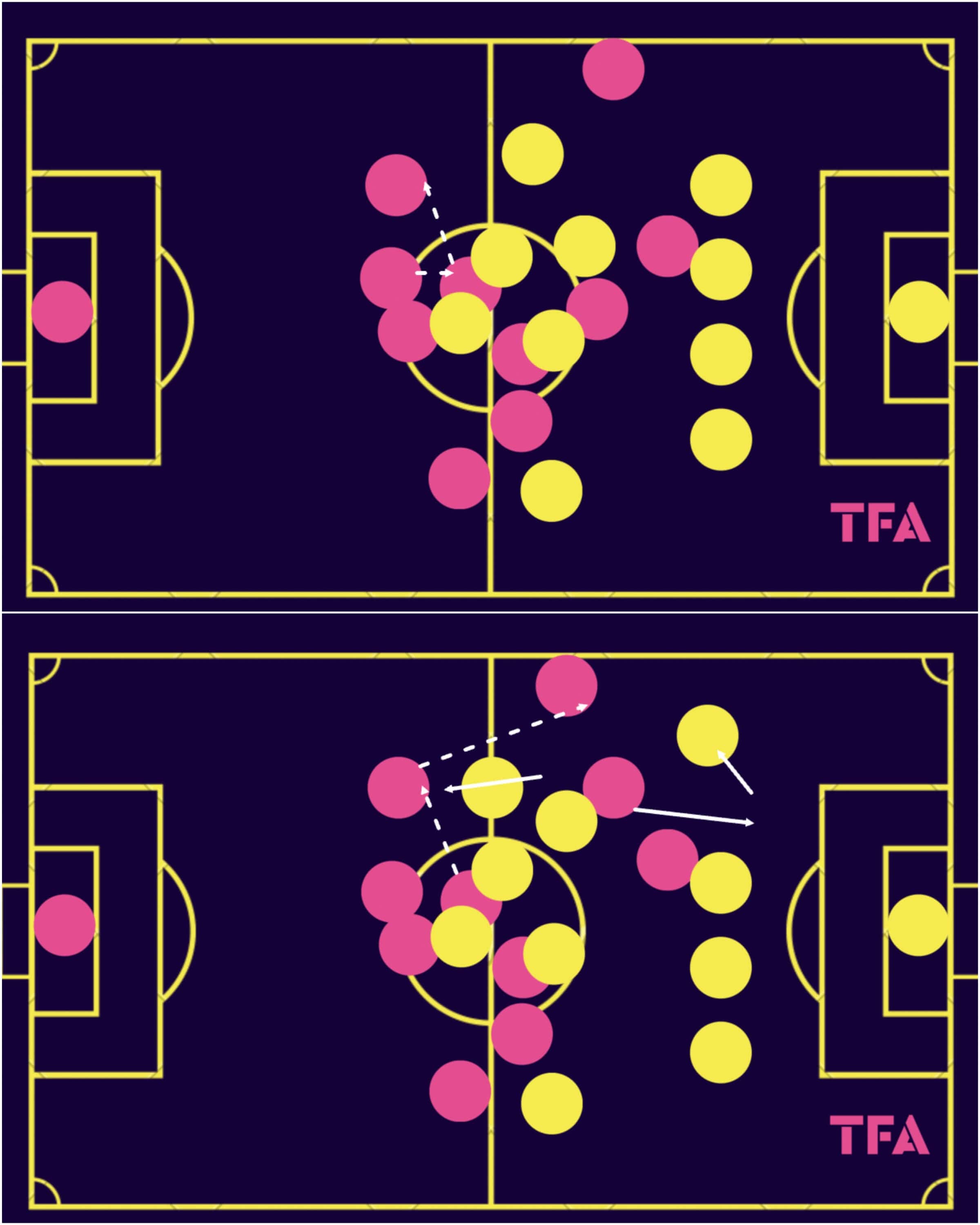
In figure 3, we see another example of Morocco’s defending against Germany, this time focusing on the right-winger and how Germany easily manipulated her press and played past her.
Firstly, the pass was far too easy again for Germany to play from the central centre-back to the holding midfielder. However, with pressure quickly mounting from Morocco’s forwards as they reacted to the pass, the midfielder quickly relayed the ball out to the left centre-back.
This pass drew Morocco’s right-winger upfield as she sought to prevent Germany’s left centre-back from enjoying time and space on the ball. This just served to open up a lot of space for FC Bayern’s Klara Bühl on the left wing, who could enjoy a couple of seconds to compose herself before Morocco’s right-back, Sarah Kassi, reached her.
Kassi’s pressing created another issue, as another German attacker would try to attack the space behind her, giving Bühl a good through passing option in the channel between Kassi and the right centre-back.
But Bühl also enjoyed taking Kassi on a lot in this game and got the better of her on quite a few occasions with her dribbling technique, making the fact she could often receive with tonnes of space on the left an even more dangerous prospect for Reynald Pedros’ side.
This particular sequence occurred just five minutes into the game and wasn’t the first (and certainly wasn’t the last) instance of this happening over the 90 minutes. Thankfully, for Morocco, this didn’t persist throughout the group stage.
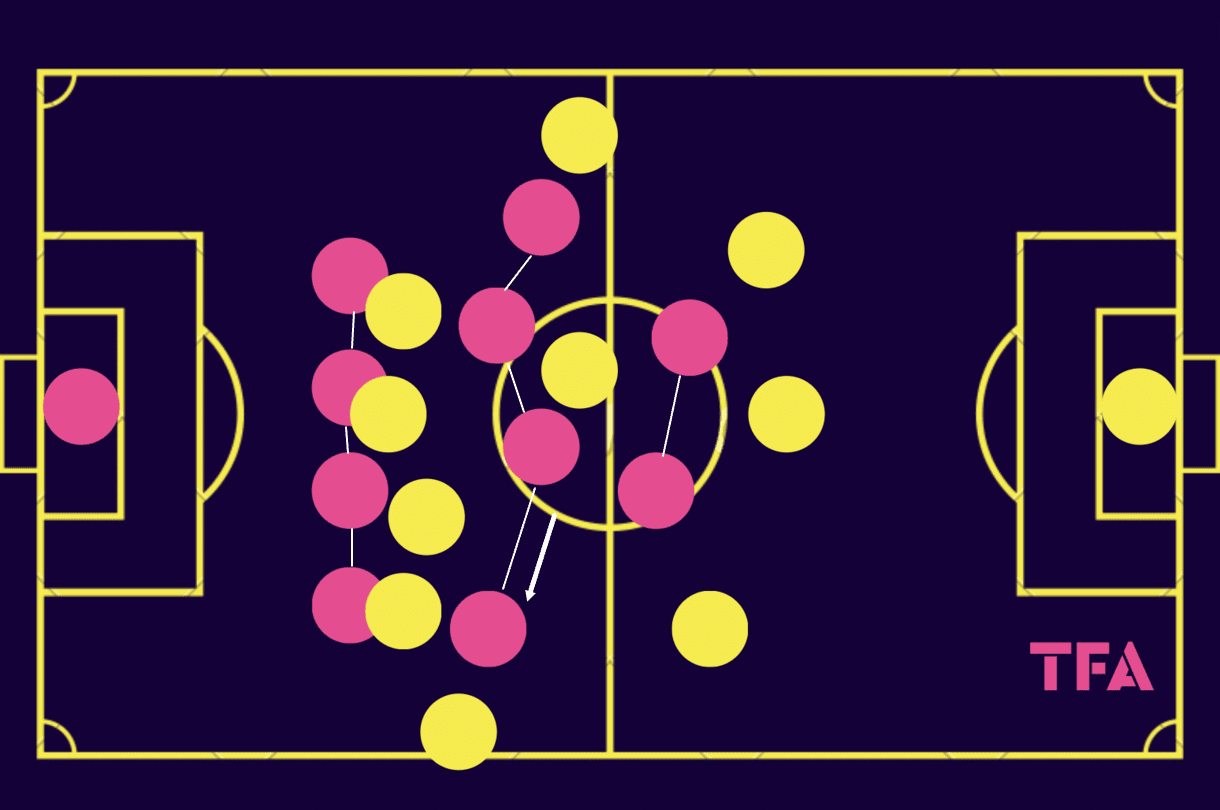
While Morocco largely continued defending in a very position-oriented structure throughout the group stage, they became far less interested in pressing the opposition’s centre-backs from game two onwards.
In the above image, with Morocco now represented by the pink dots and Korea Republic represented by the yellow dots, we can see an example of how Morocco’s right winger focused more on the passing options behind her in this contest compared to the previous game where the Moroccan wingers were occupied with pressing the opposition’s backline aggressively, which didn’t work.
At this point above, the ball is with Morocco’s right centre-back. The centre-forwards do a decent job of preventing the passes into midfield while also retaining access to the left centre-back.
Morocco’s right-winger, Sakina Ouzraoui, spots that the big switch of play to the left wing is on, so she departs from the 4-4-2 structure to cover that option. This is an example of option-oriented marking and something we saw much more of from Morocco’s wingers in games two and three. This was far more effective at preventing the opposition’s progression than the hazardous roles they played in game one.
Korea Republic found it very difficult to progress through the middle of the park with ground passes in this game, so they were often forced long by Morocco’s defensive structure. Korea Republic did well to win aerial balls and gain territory in this way, but they were often dispossessed on the edge of the final third as they struggled to go the distance and really break through the Moroccan backline, who defended well on the ground.
The need to keep the shape compact
You’ll hear it endlessly: a team needs to keep their shape compact without the ball. Morocco inevitably failed to do this versus Germany in game one, which played a massive part in the final scoreline.
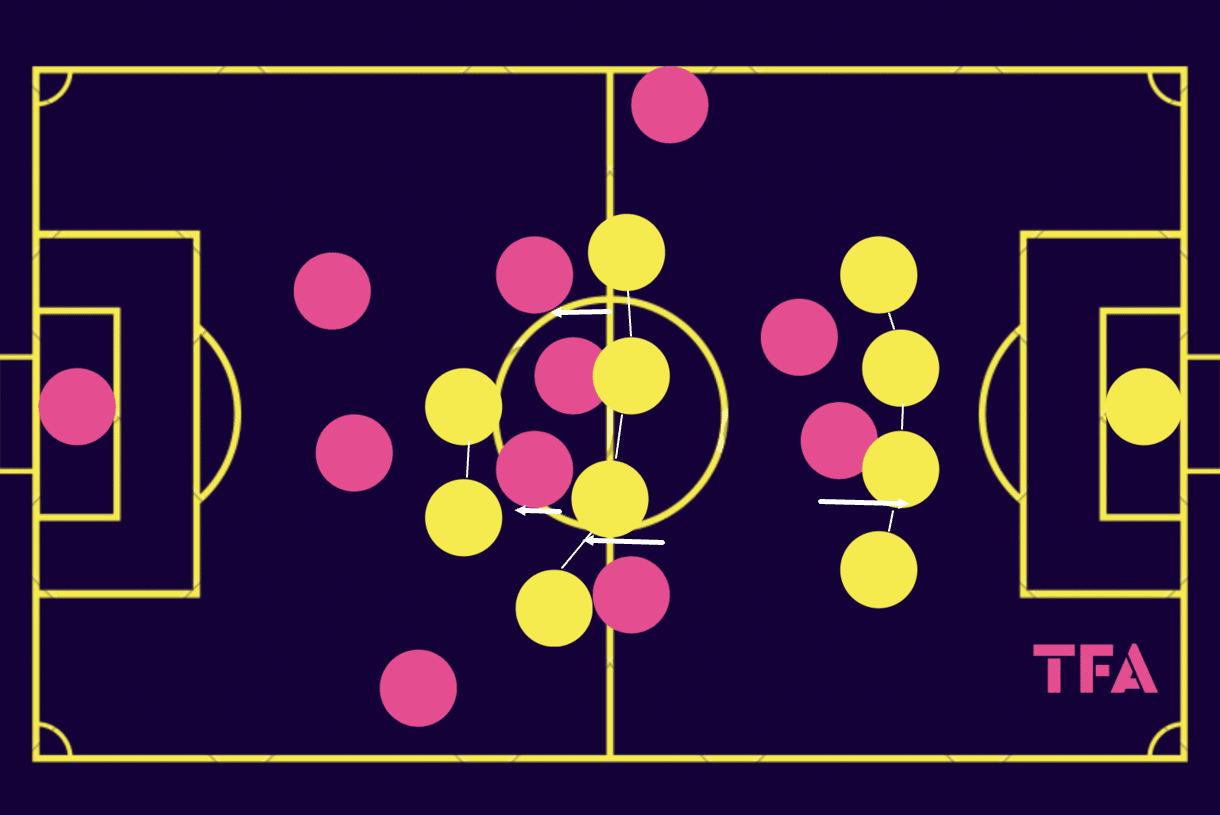
There were a couple of big reasons for this. Firstly, as mentioned, Morocco were far more concerned with pressing the opponent’s centre-backs aggressively versus Germany, and as their centre-forwards pushed high on the German centre-backs, creating space behind them for Germany’s midfielders, the Moroccan midfield would try to keep up, as figure 5 from about the 41st minute of the game displays.
At the same time, Morocco’s centre-backs were concerned about Germany’s threat in behind. They didn’t follow suit, preferring to minimise the distance between them and the goalkeeper for the likes of Alexandra Popp to exploit.
This resulted in massive gaps forming between Germany’s midfield and backline, which Die Nationalelf could exploit on numerous occasions. The irony of this was that as Popp quickly dropped in to receive to feet, she could link up with Lina Magull, Klara Bühl or Jule Brand running in behind from an even better playmaking position, still threatening the space behind the Atlas Lionesses’ backline.
Morocco were especially vulnerable in the half-spaces, though, where the German attackers often received with time and space to turn before playing a dangerous forward pass or taking the defender on themselves.
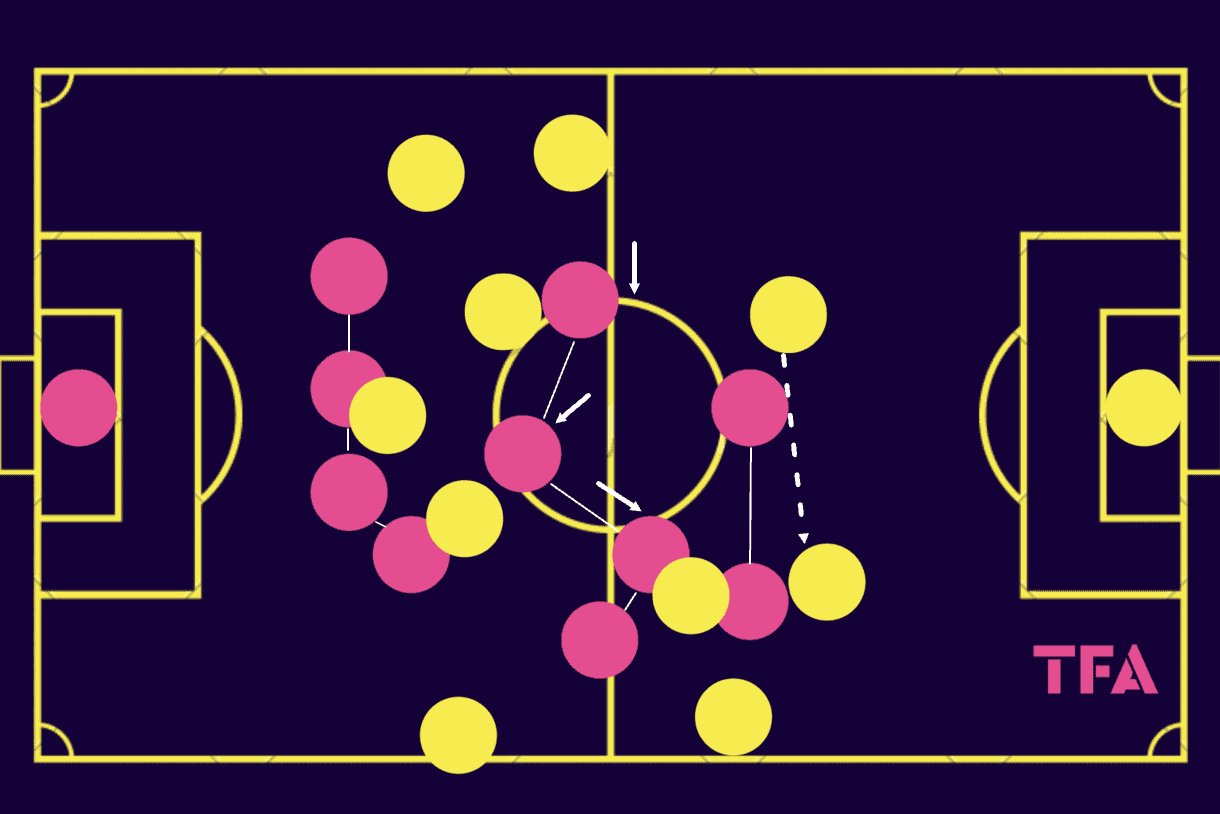
Morocco did a better job of protecting the space between the midfield and backline in games two and three, with figure 6 providing an example of this from game two versus Korea Republic. Again, Morocco will be represented by the pink dots.
Creating a midfield stagger was critical for Morocco’s defensive structure and protection of the space between the lines. Depending on what side of the pitch the ball was on, the ball-near midfielder, either Élodie Nakkach or Ghizlane Chebbak, would push forward to the near passing option on that side. At the same time, the other would drop in behind, essentially creating a midfield diamond with them and the wingers.
This offered Morocco better protection between the lines and denied the Korea Republic’s and Colombia’s more advanced players the freedom that Germany had enjoyed versus Reynald Pedros’ side.
Conclusion
To conclude this tactical analysis and scout report, we hope it’s clear how Morocco improved after their German demolition in game one to keep two straight clean sheets on their way to the knockout rounds.
They had some massive fundamental defensive issues in their first game but did well to logically address the issues and recover to form a far more solid defensive unit by game two.
France will undoubtedly face a much more challenging prospect than Germany did in game one in the Round of 16. However, I’d still say with a three-person backline and enough forward passing options ahead, Morocco can be got at.
Having said that, France aren’t that solid themselves. Morocco will hope to create a very transitional contest as they did versus Colombia in game three. They can succeed in that chaos and will be well up for the challenge, so it’s safe to say we’re in for an intriguing clash.





Comments